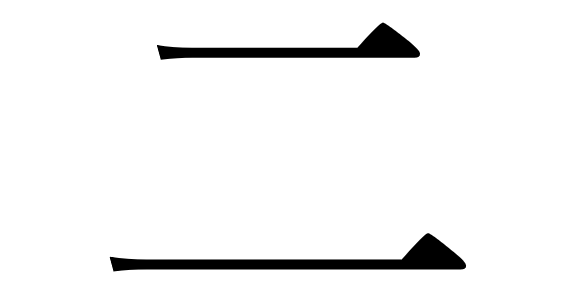
The history of the first kanji that makes many learners of Japanese want to pull their hair out, and why their initial guess isn’t entirely wrong.
One of the most intimidating things about learning Japanese is the writing system. There are three different sets of characters you’ll need to become proficient in, and while two of them, hiragana and katakana, aren’t too difficult to master, kanji, the set originally imported from China, is a high hurdle.
Japan’s Ministry of Education has designated 2,136 characters as “general-use kanji,” and while you may not need to know each and every one to function in Japanese society, you’ll need a firm mental grip on several hundred if you really want to integrate yourself into the cultural or professional spheres. With so many to learn, most structured courses, and self-studiers as well, start with the easiest kanji, ichi, which means one.
▼ Ichi
While you could possibly interpret a horizontal line in a few different ways, it’s not too hard to wrap your head around the fact that in Japan, a single sideways stroke represents the concept, and thus the word for, “one.” After inputting that in their brains, most learners will turn the page of their textbook and find the kanji for ni, or “two.”
This seems like a pretty logical progression, right? One horizontal line means one, two horizontal lines means two. The next on the kanji study list is generally san, or “three,” and you can probably guess where this is going.
Wow, if all kanji are this straightforward, you’ll have those 2,136 general-use ones memorized in no time, right? Okay, let’s move on to yon, or “four,” although at this point it seems like just a formality, since in keeping with the established pattern it’ll probably be-
Whoa, hold up there. Is this some kind of joke? And if it is, don’t the people who developed kanji know that comedy is supposed to follow the rule of three, not the rule of four?
If there were any justice in the world, the kanji for “four” should be written like this, right?
But try writing that on your kanji test, and your teacher is likely to strain a forehead muscle from cocking an eyebrow harder than he would if you referred to yourself with the macho pronoun ore when speaking in class. However, history would be on your side, even if your instructor probably wouldn’t, since long, long ago the kanji 亖 actually was an acceptable way of writing “four.”
▼ Take that, Teach!
However, 亖 never shows up in contemporary usage, and it takes a fair bit of wrangling to even get it to appear when typing in Japanese (it’s literally easier to summon a dragon with a Japanese word processor than to produce the kanji 亖). So how did it get replaced, and why?
Let’s start with the “how” part of that question. As mentioned above, while Japan has developed some kanji of its own over the years, the writing system originally came from China. There, too, 亖 was once an acceptable way of writing “four.” However, somewhere along the line, people started using the kanji 四 to represent “four” as well.
四 seems like a strange choice at first. Originally, it meant “breath” and was meant to be a visual representation of teeth or a tongue inside a mouth (“mouth” by itself being written with the kanji 口). However, the Chinese pronunciations of 四 and 亖 were identical, and so some people started using 四 to represent “four.” Eventually, 四 became the preferred rendering for “four,” which then prompted the development of a new kanji for “breath,” 息 (a compound of the kanji for “self,” 自, and “heart,” 心).
But what turned popular opinion, and eventually society as a whole, against 亖? There was no official changeover decree, owing to language’s nature as a gradually and constantly evolving thing. However, the common-sense explanation is that while 一, 二, and 三 are all pretty easy to identify with a momentary glance, 亖 had moved beyond, or at least approached, the tipping point where the eye and mind can instantaneously process the information without requiring conscious counting.
From a practical standpoint, a line had to be drawn somewhere in stacking horizontal lines increasingly higher. After all, while the meaning of 八, the kanji for “eight,” may not be intrinsically understandable, it saves people from having to squint at small-font text to see if there are eight or nine strokes crammed together in a small vertical space. Others have pointed out that this concept that four repeating visual elements is too many appears in Roman numerals as well, which capped its vertical lines at three after Ⅰ, Ⅱ, and Ⅲ and then started mixing things up with Ⅳ.
So once again, yes, Japanese can be a difficult language to learn, sometimes frustratingly so. However, there’s often a reason for things being done the way they are.
Sources: IT Media, Okijiten (1, 2)
Top image ©SoraNews24
Insert images: SoraNews24, Pakutaso
Follow Casey on Twitter, where he’d like to thank Sakamoto-sensei for not getting too upset when he used “ore” during a heated in-class debate with another student.







 Japanese study tip: Imagine kanji characters as fighting game characters, like in this cool video
Japanese study tip: Imagine kanji characters as fighting game characters, like in this cool video Pokémon Center apologizes for writing model Nicole Fujita’s name as Nicole Fujita
Pokémon Center apologizes for writing model Nicole Fujita’s name as Nicole Fujita Twitter users say Japanese Prime Minister’s name is hiding in the kanji for Japan’s new era name
Twitter users say Japanese Prime Minister’s name is hiding in the kanji for Japan’s new era name Renowned Japanese calligraphy teacher ranks the top 10 kanji that foreigners like
Renowned Japanese calligraphy teacher ranks the top 10 kanji that foreigners like Tired of wasting paper practicing your kanji? Try these reusable water-activated practice sheets
Tired of wasting paper practicing your kanji? Try these reusable water-activated practice sheets McDonald’s new Happy Meals offer up cute and practical Sanrio lifestyle goods
McDonald’s new Happy Meals offer up cute and practical Sanrio lifestyle goods Studio Ghibli releases new action figures featuring Nausicaä of the Valley of the Wind characters
Studio Ghibli releases new action figures featuring Nausicaä of the Valley of the Wind characters Super Nintendo World expansion gets delayed for several months at Universal Studios Japan
Super Nintendo World expansion gets delayed for several months at Universal Studios Japan All-you-can-drink Starbucks and amazing views part of Tokyo’s new 170 meter-high sky lounge
All-you-can-drink Starbucks and amazing views part of Tokyo’s new 170 meter-high sky lounge Katsudon vs. tonkatsu vs. katsu sandwich – What’s the best way to eat pork cutlet in Japan?
Katsudon vs. tonkatsu vs. katsu sandwich – What’s the best way to eat pork cutlet in Japan? Studio Ghibli glasses cases let anime characters keep an eye on your spectacles
Studio Ghibli glasses cases let anime characters keep an eye on your spectacles Arrest proves a common Japanese saying about apologies and police
Arrest proves a common Japanese saying about apologies and police More foreign tourists than ever before in history visited Japan last month
More foreign tourists than ever before in history visited Japan last month Ghibli action figures bring Nausicaä of the Valley of the Wind soldiers to life in 3-D form
Ghibli action figures bring Nausicaä of the Valley of the Wind soldiers to life in 3-D form Hamster abandoned at Tokyo ramen restaurant gets new home
Hamster abandoned at Tokyo ramen restaurant gets new home Disney princesses get official manga makeovers for Manga Princess Cafe opening in Tokyo
Disney princesses get official manga makeovers for Manga Princess Cafe opening in Tokyo Starbucks reopens at Shibuya Scramble Crossing with new look and design concept
Starbucks reopens at Shibuya Scramble Crossing with new look and design concept Beautiful new Final Fantasy T-shirt collection on the way from Uniqlo【Photos】
Beautiful new Final Fantasy T-shirt collection on the way from Uniqlo【Photos】 Is the new Shinkansen Train Desk ticket worth it?
Is the new Shinkansen Train Desk ticket worth it? Foreign English teachers in Japan pick their favorite Japanese-language phrases【Survey】
Foreign English teachers in Japan pick their favorite Japanese-language phrases【Survey】 Beautiful Sailor Moon manhole cover coasters being given out for free by Tokyo tourist center
Beautiful Sailor Moon manhole cover coasters being given out for free by Tokyo tourist center Studio Ghibli releases Kiki’s Delivery Service chocolate cake pouches in Japan
Studio Ghibli releases Kiki’s Delivery Service chocolate cake pouches in Japan Japan’s bone-breaking and record-breaking roller coaster is permanently shutting down
Japan’s bone-breaking and record-breaking roller coaster is permanently shutting down New definition of “Japanese whiskey” goes into effect to prevent fakes from fooling overseas buyers
New definition of “Japanese whiskey” goes into effect to prevent fakes from fooling overseas buyers Our Japanese reporter visits Costco in the U.S., finds super American and very Japanese things
Our Japanese reporter visits Costco in the U.S., finds super American and very Japanese things Studio Ghibli unveils Mother’s Day gift set that captures the love in My Neighbour Totoro
Studio Ghibli unveils Mother’s Day gift set that captures the love in My Neighbour Totoro Domino’s Japan now sells…pizza ears?
Domino’s Japan now sells…pizza ears? New Japanese KitKat flavour stars Sanrio characters, including Hello Kitty
New Japanese KitKat flavour stars Sanrio characters, including Hello Kitty One of Tokyo’s most famous meeting-spot landmarks is closing for good
One of Tokyo’s most famous meeting-spot landmarks is closing for good Kyoto creates new for-tourist buses to address overtourism with higher prices, faster rides
Kyoto creates new for-tourist buses to address overtourism with higher prices, faster rides Sales of Japan’s most convenient train ticket/shopping payment cards suspended indefinitely
Sales of Japan’s most convenient train ticket/shopping payment cards suspended indefinitely Sold-out Studio Ghibli desktop humidifiers are back so Totoro can help you through the dry season
Sold-out Studio Ghibli desktop humidifiers are back so Totoro can help you through the dry season Japanese government to make first change to romanization spelling rules since the 1950s
Japanese government to make first change to romanization spelling rules since the 1950s Ghibli founders Toshio Suzuki and Hayao Miyazaki contribute to Japanese whisky Totoro label design
Ghibli founders Toshio Suzuki and Hayao Miyazaki contribute to Japanese whisky Totoro label design Doraemon found buried at sea as scene from 1993 anime becomes real life【Photos】
Doraemon found buried at sea as scene from 1993 anime becomes real life【Photos】 Tokyo’s most famous Starbucks is closed
Tokyo’s most famous Starbucks is closed One Piece characters’ nationalities revealed, but fans have mixed opinions
One Piece characters’ nationalities revealed, but fans have mixed opinions We asked a Uniqlo employee what four things we should buy and their suggestions didn’t disappoint
We asked a Uniqlo employee what four things we should buy and their suggestions didn’t disappoint Princesses, fruits, and blacksmiths: Study reveals the 30 most unusual family names in Japan
Princesses, fruits, and blacksmiths: Study reveals the 30 most unusual family names in Japan Foreigners in Japan vote for the best-looking katakana character
Foreigners in Japan vote for the best-looking katakana character Foreigners misreading Japanese kanji of “two men one woman” is too pure for Japanese Internet
Foreigners misreading Japanese kanji of “two men one woman” is too pure for Japanese Internet W.T.F. Japan: Top 5 most difficult kanji ever【Weird Top Five】
W.T.F. Japan: Top 5 most difficult kanji ever【Weird Top Five】 Kanji fail — Japanese parents shocked to learn their baby girl’s name has inappropriate meaning
Kanji fail — Japanese parents shocked to learn their baby girl’s name has inappropriate meaning Japan announces Kanji of the Year for 2019, and it was really the only logical choice
Japan announces Kanji of the Year for 2019, and it was really the only logical choice Does Japan’s five-yen coin need a foreigner-friendly redesign?
Does Japan’s five-yen coin need a foreigner-friendly redesign? Four new era names the Japanese government rejected before deciding on Reiwa
Four new era names the Japanese government rejected before deciding on Reiwa Japanese teacher’s explanation about “individuality” to kids has a deep, beautiful meaning
Japanese teacher’s explanation about “individuality” to kids has a deep, beautiful meaning Kanji Tetris is the coolest way to practice and play with Japanese that we’ve ever seen【Video】
Kanji Tetris is the coolest way to practice and play with Japanese that we’ve ever seen【Video】 “Gold” named 2016 Kanji of the Year
“Gold” named 2016 Kanji of the Year Struggling with Japanese? Let Tako lend you a hand…or five
Struggling with Japanese? Let Tako lend you a hand…or five The packing-tape calligraphy master visits us and shows us how to make our own sticky signs【Pics】
The packing-tape calligraphy master visits us and shows us how to make our own sticky signs【Pics】 Draft bill proposal seeks to curtail unconventional “kirakira” kanji name readings in Japan
Draft bill proposal seeks to curtail unconventional “kirakira” kanji name readings in Japan Poop Kanji-Drill toilet paper is the best way to accomplish your Japanese studying doo-ties
Poop Kanji-Drill toilet paper is the best way to accomplish your Japanese studying doo-ties What’s funnier and more likely to make you study than poo? How about male pattern baldness?
What’s funnier and more likely to make you study than poo? How about male pattern baldness?
Leave a Reply